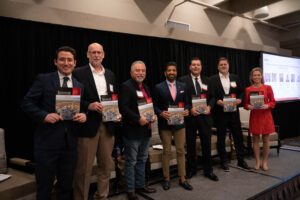Writer: Jerrica DuBois
 3 min read July 2023 — Being intentional about changes became the lingering call to action from the first panel discussion at the recent Invest: San Antonio 2022-2023 leadership summit. The panel, titled ‘Building Blocks: Navigating development and demand in San Antonio’s changing landscape for real estate,’ focused on shifting project objectives, the build-to-rent market, labor challenges and affordable housing. Karl Joeris of Joeris General Contractors, Thad Rutherford at SouthStar Communities, Leo Gomez of Brooks and Thomas Roth of the San Antonio Housing Trust served on the panel to provide insights.
3 min read July 2023 — Being intentional about changes became the lingering call to action from the first panel discussion at the recent Invest: San Antonio 2022-2023 leadership summit. The panel, titled ‘Building Blocks: Navigating development and demand in San Antonio’s changing landscape for real estate,’ focused on shifting project objectives, the build-to-rent market, labor challenges and affordable housing. Karl Joeris of Joeris General Contractors, Thad Rutherford at SouthStar Communities, Leo Gomez of Brooks and Thomas Roth of the San Antonio Housing Trust served on the panel to provide insights.
“No longer are people looking to build another traditional multifamily development or neighborhood,” said Gomez. “Retail and food and drink has got to be in the mix. We’re looking for podium development on small acreage, retail on the ground floor, structured parking, and residential at the top. It’s happening at Brooks, and I can imagine what the opportunities look like for the rest of San Antonio.”
One component of the housing need the panel went in depth on is build-to-rent, which are detached units built specifically for the purpose of long term rental. Many companies in San Antonio are picking up on the trend. Developers such as TriCon Residential, Embrey and Preston Hollow Community Capital are creating build-to-rent communities across Alamo City. As interest rate hikes continue to increase mortgage rates, it’s getting more difficult for residents of San Antonio to afford to own a home. These communities provide another option for those pushed into renting, allowing them to have more living space for their families and yard as opposed to apartment balconies.
“There are two different schools of thought,” said Roth in regards to build-to-rent. “There are the people who have the means to live anywhere they want. They want more of a lock and leave, but still want the benefits of a single family home structure, whether it’s people that travel a lot, get relocated, or the elderly. Then there are the people who have outgrown traditional apartment-style living but can’t afford to buy a house. This is the next best thing where you have a 3 or 4 bedroom home, you have a yard, but it’s more because you can’t afford to buy a home in the San Antonio area.”
The panel also discussed the current labor challenges. San Antonio has already caught national attention in this regard with the unprecedented Ready to Work initiative. The program offers tuition assistance, helps applicants prepare for interviews and improve soft skills, and has the support of hundreds of employers and workforce agencies. To date, Ready to Work has interviewed 6,619 applicants and enrolled 3,234 in approved training courses.
“There is definitely a need for workforce,” said Joeris. “What we are doing in the general contracting community is collaborating with our educational facilities. We are working with them through vocational and training programs. Also, local, state and federal policies that support internships and apprenticeships in the construction business is what we would like to see. We also have to diversify the workforce. There are a lot of small businesses and minority companies looking to expand. We have to find them and partner with them to utilize their labor and give them opportunities. We also need to foster a positive image of construction. There are a lot of advantages and construction is moving into an area where there is a lot of high technology in it. However, AI will not take our construction jobs, so we will still need our carpenters and bricklayers.”
As the panel began to wrap up, the conversation turned to what can be done to turn around those communities in San Antonio that still need more development, specifically the area around the AT&T Center. Gomez pointed out that the success they have had at Brooks did not happen by accident; it was deliberate. This prompted further commentary on the importance of being intentional to change the landscape of Alamo City.
“Part of the intentionality Leo is talking about is the regionalized economic development strategy,” said Rutherford. “It’s going to take that regionalized attitude for the smaller towns and cities around San Antonio that feed economic development into the city. We have very strong chambers, and that regionalized economic development strategy and the strong business community is going to take the outside investment into the region and we’ll be able to do some of those things we’ve been talking about.”
For more information, visit:

